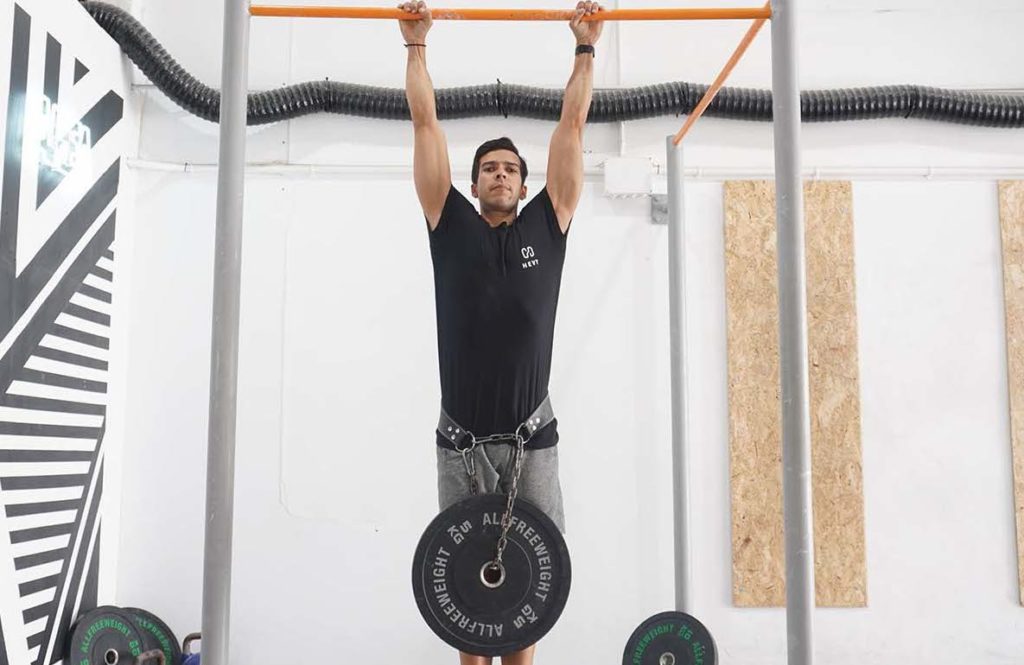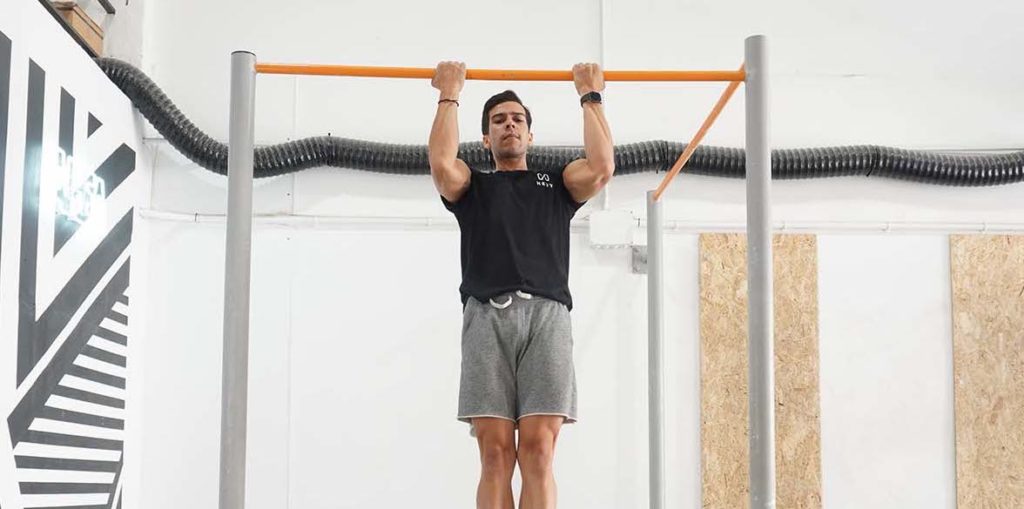How do scapular pull ups increase shoulder mobility and strength?
One of the most valuable skills every trainee needs to learn is scapular retraction – the act of bringing your shoulders back and chest out. Doing so improves lat engagement, keeps your shoulders safe, and allows you to maintain a natural lumbar curve (1, 2).
Scapular retraction seems simple enough, and most people think they know how to do it. But pulling this position off effectively requires good stability and proper back engagement. Scapular pull-ups are a fantastic exercise for teaching you shoulder retraction because that is all you have to do. With each repetition, you reinforce the movement pattern and learn how to bring your scapulae in a good position for pushing and pulling exercises.
How to do Scapular Pull Ups
- Grab a pull-up bar with an even overhand grip. Begin with a shoulder-width grip as you do the exercise for the first time.
- Engage your abs and bend your knees to start hanging from the pull-up bar.
- As you hang from the bar, keep your abs and glutes engaged to remain still and not swing back and forth.
- Take a breath and initiate the scapular pull-up by bringing your shoulders back and down. Keep your arms straight. Doing so will elevate your body slightly.
- You can think of a mental cue such as bending the pull-up bar with your hands, allowing you to engage your back better and produce more force.
- Hold the retracted position for a second or two, making sure to feel your back muscles working.
- Relax your body and allow your shoulders to move forward and up. Exhale.
What muscles do scapular pull ups activate?
The scapulae, also known as shoulder blades, are two winged bones that move up and down the back, gliding on the ribcage. The scapulae attach the arms to the torso via the shoulder joint, which allows us to move our arms in many ways (3).

Three primary muscles control scapular retraction: the latissimus dorsi, rhomboids, and trapezius (3). Scapular pull-ups primarily train these muscles, which need to produce enough force to move us up without the assistance of the biceps and forearms.
Our core muscles (abs, transverse abdominis, obliques, erector spinae, and glutes) also contribute to the movement. The collective of muscle groups contracts and keeps us stable and in position as we do scapular pull-ups. Our shoulders and arms also work during scapular pull-ups, allowing us to support ourselves in a hanging position. Scapular pull-ups are also suitable for improving grip strength, especially when done on a thicker pull-up bar.
What is the difference between a pull up and a scapular pull up?
Scapular pull-ups are the initial portion of a full pull-up. As you hang from the pull-up bar, scapular retraction is the first action you need to take before you start pulling through your forearms, biceps, and lats. If you don’t retract your scapula, you won’t be able to engage your back well, and you might increase the risk of shoulder impingement (2).
The most notable difference is that scapular pull-ups only have you practice the first two inches of the range of motion. In contrast, pull-ups have you lift and lower your body through a significantly more extended range of motion, resulting in higher lat and bicep activation (4).
In essence, scapular pull-ups are the movement everyone should master before graduating to pull-ups. Of course, you should also do scapular pull-ups later, even if you can do ten, twenty, or more regular pull-ups.
Variations and Modifications of the Scapular Pull Ups
1. Extended Scapular Pull Up
The extended scapular pull-up is a simple variation of the movement where the goal is to retract your scapula as much as you can. The stronger you get, the more you’ll be able to move your body into a horizontal position that can eventually result in a front lever hold.
2. Assisted Scapular Pull Up
Scapular pull-ups can be challenging to do at the beginning, which is why it’s a good idea to do the assisted version. One option would be to keep your feet touching the floor slightly – for instance, by keeping your toes in contact with the floor. Doing so would prevent you from supporting your entire body, making it easier to start practicing scapular retractions.
3. Weighted Scapular Pull Up

If the regular version feels too easy, you can attach a weight to yourself via a special belt and do the exercise. Alternatively, place a weight vest over your shoulders for extra resistance.
Mistakes to Avoid
A common mistake relating to scapular pull-ups is to underestimate the exercise and do too much of it. While seemingly simple, scapular pull-ups are a challenging whole-body activity that trains multiple muscle groups and leads to fatigue. You have to account for the training volume and avoid doing more than a few sets of scapular pull-ups in one session.
Another mistake related to scapular pull-ups is to use momentum to do the exercise. For instance, thrusting yourself up and not controlling the descent can turn scapular pull-ups into a modified kipping pull-up, which takes away the benefits of the movement. Plus, doing so causes you to swing back and forth, making the exercise even less effective. Slow and purposeful execution is essential for scapular pull-ups.
You should also lookout for the mistake of using your arms to do scapular pull-ups. The movement seems easy enough at first glance, so most people figure they can do it effortlessly. But as they hang from the bar, many find it challenging to achieve scapular retraction, so they bend their arms slightly. Doing so defeats the purpose of the movement and turns the scapular pull-up into a half pull-up.
Similar Exercises to the Scapular Pull Ups:
Dead Hang

Dead hangs are one of the most straightforward exercises you could do. Grab a pull-up bar and hang from it while having your body relaxed and motionless. The dead hang is similar to scapular pull-ups because it makes up half of the exercise, excluding the shoulder retraction. You can also use dead hangs to get comfortable with holding onto a pull-up bar and staying still.
Pull Up

Pull-ups are also quite similar to scapular pull-ups. In both cases, you hang from a pull-up bar, engage your core to stay still, and use your back muscles to produce force. The primary difference is that pull-ups also involve your arms to pull you up, whereas scapular pull-ups engage the back and train your arms isometrically.
Negative Pull-Up
Negative pull-ups are somewhat opposite to the classic exercise. Here, the goal is to raise yourself to the top position somehow (for example, by jumping) and lower yourself as slowly as you can. Negative pull-ups are similar to scapular pull-ups because both movements improve back engagement and build the strength and balance you need to do a full pull-up.

